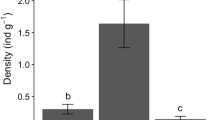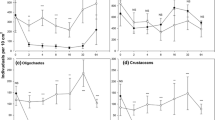Abstract.
In the Lesina Lagoon (southern Italy), three species of crustacean mesograzers – the isopods Idotea baltica Pallas and Sphaeroma serratum Fabricius, and the amphipod Gammarus insensibilis Stock – dominate the epifaunal assemblage associated with the Rhodophyta Gracilaria verrucosa (Hudson) Papenfuss. We examined in laboratory feeding assays the palatability of the red macroalga to each of the three mesograzer species. Furthermore, we used a cage experiment to investigate the actual impact of the mesograzer assemblage on the growth of Gracilaria under field conditions. Cages with different mesh sizes were used to test the hypothesis that mesograzer effect on the macroalga is size dependent. Laboratory assays indicated for all the mesograzer species a negative effect on Gracilaria; in particular, I. baltica and G. insensibilis actively consumed the macroalga, whereas S. serratum grazing activity was weaker but nonetheless statistically significant. In contrast, Gracilaria was not significantly grazed under field conditions. When mesograzers were totally excluded, algal growth showed a strong negative variation compared to controls where access was not precluded (ca. 43% reduction in wet mass). Simultaneously, the abundance of the encrusting bryozoan Conopeum seurati increased significantly (from 1.5 to 24.7 mg g–1, corresponding to 1.7% and 28.9% cover of algal surface); an analogous increase was detected in the abundance of other sessile macrofauna (i.e. the bivalve Mytilaster marioni). When only juvenile, small-sized epifauna were given access to Gracilaria, algal mass change was reduced by around 36%. The abundance of both encrusting bryozoans and sessile bivalves showed significant positive variations, close to those observed in the total exclusion treatment. Our results suggest that, even though Gracilaria represents a potentially palatable resource for mesograzers in the Lesina Lagoon, the actual impact of epifauna on the macroalga might be beneficial, through an indirect control on the development of fouling epibionts. In addition, such a positive effect may be size specific, since the juvenile, small-sized component of the mesograzer assemblage exerted a significantly weaker control on fouling development, even at unnaturally high densities. We suggest that the occurrence of different functional roles among mesograzer size classes might represent a significant controlling factor for the establishment of mesograzer–epibiont–host plant interactions, and for their effects on macrophytal productivity.
Similar content being viewed by others
Author information
Authors and Affiliations
Additional information
Electronic Publication
Rights and permissions
About this article
Cite this article
, ., , . Indirect, size-dependent effects of crustacean mesograzers on the Rhodophyta Gracilaria verrucosa (Hudson) Papenfuss: evidence from a short-term study in the Lesina Lagoon (Italy). Marine Biology 138, 1163–1173 (2001). https://doi.org/10.1007/s002270100545
Received:
Accepted:
Issue Date:
DOI: https://doi.org/10.1007/s002270100545




